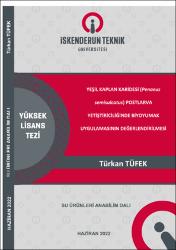| dc.contributor.advisor | Genç, Münevver Ayçe | |
| dc.contributor.author | Tüfek, Türkan | |
| dc.date.accessioned | 2023-12-24T09:40:35Z | |
| dc.date.available | 2023-12-24T09:40:35Z | |
| dc.date.issued | 2022 | en_US |
| dc.identifier.citation | Tüfek, T. (2022). Yeşil kaplan karidesi (Penaeus semisulcatus) postlarva yetiştiriciliğinde biyoyumak uygulamasının değerlendirilmesi (Yüksek Lisans Tezi). İskenderun Teknik Üniversitesi / Lisansüstü Eğitim Enstitüsü / Su Ürünleri Ana Bilim Dalı, Hatay. | en_US |
| dc.identifier.uri | https://hdl.handle.net/20.500.12508/2766 | |
| dc.description.abstract | Bu araştırmada yeşil kaplan karidesi (Penaeus semisulcatus) potlarvaları (başlangıç
ortalama canlı ağırlıkları 0,14±0,44 g) kapalı devre yetiştiricilik sisteminde biyoyumak
(BY) ve berrak su (BS, kontrol grubu) ortamlarında karşılaştırmalı olarak 54 gün süreyle
büyütülmüşlerdir. Üç tekerrürlü iki grup olarak planlanan deneme ‰35±0,5 tuzlulukta, 45
L hacimli tanklarda yürütülmüştür. Su sıcaklığı, pH ve çözünmüş oksijen değerleri
sırasıyla; BY grubu için 27,02±0,33°C, 7,65±0,08, 6,23±0,41 mg/L ve BS grubu için
27,05±0,24°C, 7,57±0,11, 6,44±0,22 mg/L olarak belirlenmiştir. Sonuç canlı ağırlık
kazancı (BY: 2,423±0,327 g, BS: 1,814±0,103 g), spesifik büyüme oranı (BY:
%5,329±0,159 g/gün, BS: %4,845±0,085 g/gün), yaşama oranı (BY: %62,50±2,50, BY:
%51,67±5,20) ve yem değerlendirme oranı (BY: 2,12±0,23, BS: 2,71±0,15) bakımından
gruplar arasındaki farklılıklar önemli bulunmuştur (p<0,05). Araştırma ile BY
uygulamasının yeşil kaplan karidesi postlarvalarının yetiştiricilik parametrelerine ilk kez
pozitif bir etkisi olduğu belirlenirken (p<0,05), besin madde bileşenleri ve hepatopankreas
histomorfojilerinde gruplar arasında farklılık olmadığı saptanmıştır (p>0,05 | en_US |
| dc.description.abstract | In this study, green tiger shrimp, Penaeus semisulcatus postlarvae (average initial body
weight of 0,14±0,44 g), were grown in a recirculating aquaculture system in biofloc
technology (BY) and clear water (BS, control group) medium for 54 days comparatively.
The experiment, planned in two groups with three replications, was carried out in
‰35±0.5 salinity, 45 L volume tanks. Water temperature, pH, and dissolved oxygen
values were measured as 27.02±0.33°C, 7.65±0.08, 6.23±0.41 mg/L for the BY group and
27.05±0.24°C, 7.57±0.11, 6.44±0.22 mg/L for the BS group respectively. As a result, body
weight gain (BY: 2,423±0.327 g, BS: 1.814±0.103 g), specific growth rate (BY:
5.329±0.159 g/day, BS: 4.845±0.085 g/day), survival rate (BY: Significant difference
between the groups in terms of 62.50±2.50% BS: 51.67±5.20%) and feed conversion
rate (BY: 2.12±0.23, BS: 2.71±0.15) found. In conclusion, for the first time, BY
application was compared with the BS; it was determined that positively affected the
aquaculture parameters of green tiger shrimp postlarvae were obtained from BS (p<0.05),
while there was no difference between the groups in terms of nutrient components and
hepatopancreas histomorphology (p>0,05). | en_US |
| dc.language.iso | tur | en_US |
| dc.publisher | İskenderun Teknik Üniversitesi / Lisansüstü Eğitim Enstitüsü / Su Ürünleri Ana Bilim Dalı | en_US |
| dc.rights | info:eu-repo/semantics/openAccess | en_US |
| dc.subject | Penaeus semisulcatus | en_US |
| dc.subject | Karides postlarva | en_US |
| dc.subject | Biyoyumak | en_US |
| dc.subject | RAS | en_US |
| dc.subject | Karides yetiştiriciliği | en_US |
| dc.subject | Shrimp postlarvae | en_US |
| dc.subject | Biofloc | en_US |
| dc.subject | Shrimp culture | en_US |
| dc.title | Yeşil kaplan karidesi (Penaeus semisulcatus) postlarva yetiştiriciliğinde biyoyumak uygulamasının değerlendirilmesi | en_US |
| dc.title.alternative | Assessment of efficacy of biofloc application in green tiger shrimp (Penaeus semisulcatus) postlarvae culture | en_US |
| dc.type | masterThesis | en_US |
| dc.contributor.department | Deniz Bilimleri ve Teknolojisi Fakültesi | en_US |
| dc.identifier.startpage | IV | en_US |
| dc.identifier.endpage | 45 | en_US |
| dc.relation.publicationcategory | Tez | en_US |
| dc.contributor.isteauthor | Genç, Münevver Ayçe | |
| dc.relation.index | İndeks Bilgisi Yok | en_US |
















